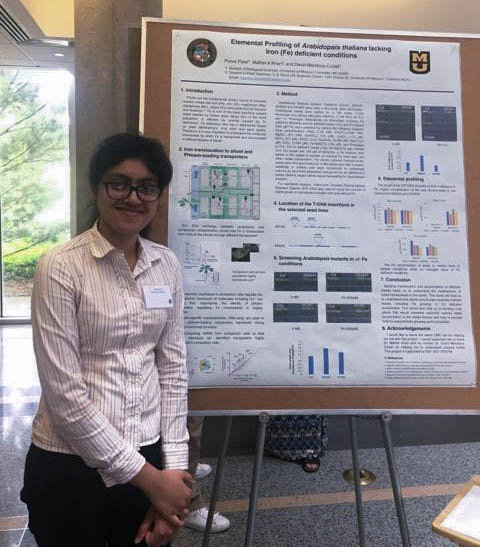Published on

Purva Patel presents her research on iron in plants during the undergraduate research fair. Patel works in Dr. Mendoza’s lab in the Bond Life Sciences Center.
By: Samantha Kummerer, Bond LSC
Purva Patel grew up captivated by newspaper articles discussing a method to grow plants without soil called hydroponics.
Today, she is one of the scientists mixing the mineral and nutrient solutions to plant seeds in this rapidly growing soil-less method.
The University of Missouri senior spent the past year working in David Mendoza-Cózatl’s Bond Life Sciences lab. Her research, which started out as a capstone project, has now turned into a pastime.
“I learn something new every day,” she said. “I did not know much about plants before joining this lab, but now I just love how all this is working at the genomic level, and I’m really very interested in understanding at what’s happening at the core of the plant.”
Patel studies how plants accumulate iron in the model organism, Arabidopsis thaliana. Iron is an important metal that provides nutrients humans need to perform important cellular processes. Plants are the primary source of iron and other essential micronutrients for humans and livestock worldwide.
Plants receive iron from the soil and transporters distribute iron from the roots to the rest of the plant. Most of the transporters involved in keeping the levels of iron balanced are not known; that’s where Patel comes in.
She started with more than 20 different Arabidopsis seed lines. Each seed line disabled a different gene, causing a loss of function that might be responsible for the movement of the metal into and out of cells.
The seeds were placed in different dishes with artificial soil that emulated real soil conditions. Some had regular levels of iron while others had an excess or deficient amount. Next, it’s time for them to grow. After they grow, she measures the roots and shoots and compares them to the wild-type plants that signify normal growth.
She narrowed down the potential genes to three seed lines. Those three types of seed lines were selected because they grew different than the normal plants and showed consistency in displaying the same leaf color and lengths of the shoots and roots.
For Patel, this step was the most exciting,
“Even in the absence of iron, the mutated plant has longer roots and the wild type does not, so I think the very visible difference between those would be the biggest thing I have come across.”
Now she wants to know the amount of other essential metals, like zinc and copper, that accumulate in plants’ tissues during various growing conditions with or without iron. For this, she uses a machine called ICP-OES (Inductively Coupled Plasma Optical Emission Spectrometry). The machine detects and measures metals in a plant sample. The results from ICP will help Patel determine how the mutants accumulate elements differently than the wild-type.
Patel explained her work is only one step in the process to understand the mechanism. She hopes her findings could produce more nutrient-rich crops someday.
“It can be nothing,” she admitted. “There is a chance, but I want it to be something.”
Whether she finds something substantial or not, Patel hopes to use her knowledge of genetics she gained in the lab to get a master’s degree in the biomedical field.
“It’s great that the science we learn in the classrooms is not only limited to there, but we get to apply it here and see the results and try to make the world a better place by using that knowledge for practical uses,” Patel explained.